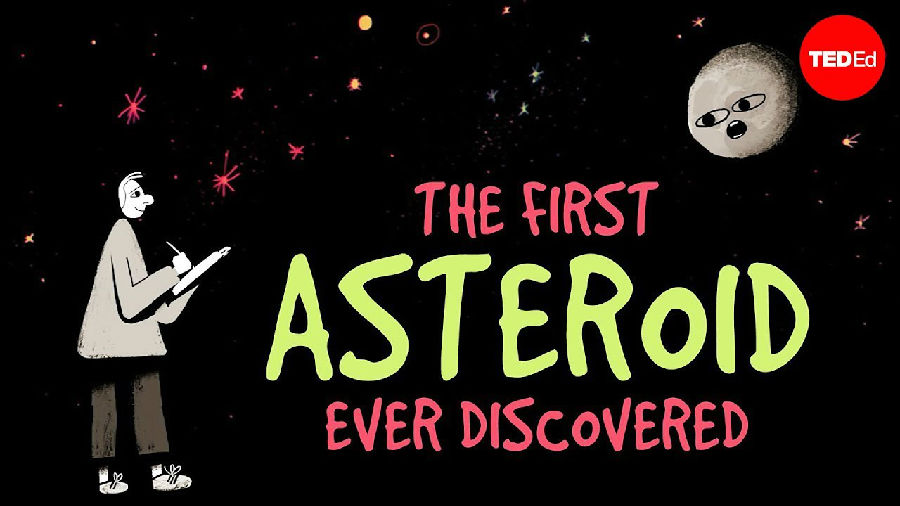On the night of January 1, 1801, Giuseppe Piazzi, a priest in Palermo, Italy, was mapping the stars in the sky.
1801年1月1日的夜晚,意大利巴勒莫市的神父朱塞普·皮亚齐正在记录天空中的繁星。
Over three nights, he'd look at and draw the same set of stars, carefully measuring their relative positions.
连续三个夜晚,他把观察到的同一个星群画在纸上,并仔细测量它们的相对位置。
That night, he measured the stars.
第一晚,他做了一次测量。
The next night, he measured them again. To his surprise, one had moved.
第二晚,他又测了一次。令他惊讶的是,有颗星移动了。
The third night, the peculiar star had moved again. This meant it couldn't be a star at all.
第三晚,那颗奇异的星又移动了。也就是说那不会是颗恒星。
It was something new, the first asteroid ever discovered, which Piazzi eventually named Ceres.
这是第一颗被人发现的小行星,皮亚齐将它命名为谷神星。
Asteroids are bits of rock and metal that orbit the Sun.
小行星是环绕太阳的岩石与金属。
At over 900 kilometers across, Ceres is a very large asteroid.
谷神星直径超过900公里,可说是巨型小行星。
But through a telescope, like Piazzi's, Ceres looked like a pinpoint of light similar to a star.
但从望远镜看去,正如皮亚齐所见,谷神星只是一个小亮点,和其他恒星一样。
In fact, the word asteroid means star-like.
其实,asteriod这个词的意思就是“如恒星般”。
You can tell the difference between stars and asteroids by the way they move across the sky.
从星体在空中移动的方式就可以分辨出恒星和小行星。
Of course, Piazzi knew none of that at the time, just that he had discovered something new.
当然,皮亚齐当时并不知道这些,他只晓得自己有了个新发现。
To learn about Ceres, Piazzi needed to track its motion across the sky and then calculate its orbit around the Sun.
要了解谷神星,皮亚齐需要记录它在空中移动的位置,然后计算出其环绕太阳的轨道。
So each clear night, Piazzi trained his telescope to the heavens.
所以,在每个月朗星稀的夜晚,皮亚齐都会用望远镜观察星空。
Night after night, he made careful measurements until finally, he couldn't.
每一晚,他都会仔细测量,直到有一天他再也无法计算。
The Sun got in the way. When Piazzi first spotted Ceres, it was here, and the Earth was here.
因为太阳阻挠了他的观察。皮亚齐首次发现谷神星时它就在这里,地球在这边。
As he tracked it each night, the Earth and Ceres moved like this until Ceres was here.
随着每晚的记录,地球和谷神星会这样移动,直到谷神星移到了这里。
And that meant that Ceres was only in the sky when it was daytime on Earth.
这表示,谷神星只有在白天才会出现。
During the day, bright sunlight made this small asteroid impossible to see.
但明亮的阳光让人很难看见这颗小行星。
Astronomers needed to calculate Ceres's orbit.
天文学家需要计算谷神星的轨道。
This would let them predict where it was going to be in the vast night sky on any given night.
这会让他们预测谷神星每个夜晚的运行路线。
But the calculations were grueling and the results imprecise.
但计算轨道十分劳神,结果也并不准确。
Many astronomers searched for Ceres, but not knowing exactly where to look, no one could find it.
许多天文学家都在寻找谷神星,但却不晓得该从何处找,所以没人能找到。

Luckily, a hardworking mathematician named Carl Friedrich Gauss heard about the lost asteroid.
幸好,一名叫卡尔·弗里德里希·高斯的勤奋数学家听说了此事。
He thought it was an exciting puzzle and went to work.
他想解开这有趣的谜题。
When he realized he didn't have the mathematical methods he needed, he invented new ones that we still use today.
当他发现自己没有所需的数学方法时,他发明了一个新的方法,沿用至今。
He derived a new orbit and new predictions of where to look for Ceres.
他推演出一套新方法来测定谷神星的轨道。
Hungarian astronomer Baron Franz Xaver von Zach searched for Ceres with Gauss's predictions.
匈牙利天文学家弗朗茲·冯·扎克男爵用高斯的轨道测定法来寻找谷神星。
After weeks of frustrating clouds, von Zach finally had clear skies on December 31, 1801.
熬过几周乌云密布的夜晚后,冯·扎克终于在1801年12月31日迎来了晴朗的天空。
He looked through his telescope and finally saw Ceres.
他终于从望远镜中看见谷神星了。
We haven't lost track of it since. Today, we've discovered hundreds of thousands of asteroids.
自那之后,谷神星的踪迹便一直在我们的掌握中。如今,我们已经发现了数十万颗小行星。
Many, including Ceres, orbit the Sun between Mars and Jupiter, while near-Earth asteroids orbit the Sun relatively close to Earth.
包括谷神星在内的许多小行星都在火星和木星间绕着太阳转,近地小行星环绕太阳的轨道也离地球更近。
When we recorded this narration, astronomers had discovered 16,407 near-Earth asteroids,
录制这段旁白的时候,天文学家已发现了16407颗近地小行星,
but since we find new asteroids all the time, that number will have grown by hundreds or thousands by the time you watch this.
但由于新的小行星不断被发现,在你观看这段视频的时候,这个数字可能已经多出了几百,甚至几千。
Today, asteroid hunters use modern telescopes, including one in space.
今天,寻找小行星的人使用现代望远镜,其中包括空间望远镜。
Computers analyze the images, and humans check the output before reporting the asteroid observations to an archiving center.
这些影像由电脑分析,通过人工检查结果,最后再将小行星的观察报告送至归档中心。
Each discovered asteroid has its unique orbit measured.
针对每颗被发现的小行星,我们都有独特的方法来测量其轨道。
An orbit lets astronomers predict where asteroids are going to be at any given time.
该轨道可让科学家预测小行星在任何时间的走向。
Most asteroid trajectories can be predicted for about 80 years
大多数测定的小行星轨道准确度可以持续80年,
though we can calculate where the best studied asteroids will be every day between now and 800 years into the future.
但对于那些详尽研究的小行星,我们甚至可计算其未来800年的每日运行轨道。
We must keep searching for asteroids in case there's one out there on a collision course with Earth.
虽然如此,我们还是要不断寻找新的小行星,以免它们撞上地球。
Astronomers don't only search for asteroids, though.
天文学家要做的不止如此。
They also study them to learn how they formed, what they're made of, and what they can tell us about our solar system.
他们也要研究小行星,了解它们如何形成,由什么元素构成以及它们和太阳系的关系。
Today, we can do something that Piazzi could only dream of: send spacecraft to study asteroids up close.
今天,我们能做到皮亚齐无法完成的事:把宇航飞船送到太空近距离观察小行星。
One spacecraft called Dawn journeyed billions of kilometers over four years to the main asteroid belt.
一艘名为“黎明号”的宇航船飞了几十亿公里,用四年多的时间进入小行星带。
There, it visited Ceres and another asteroid, Vesta.
它在那里观察了谷神星和另一颗小行星,灶神星。
Dawn's stunning images transformed Piazzi's dot of light into a spectacular landscape of craters, landslides, and mountains.
黎明号拍出的动人照片,将皮亚齐当时看见的光点放大为令人惊艳的陨石坑、滑坡和山峦。


